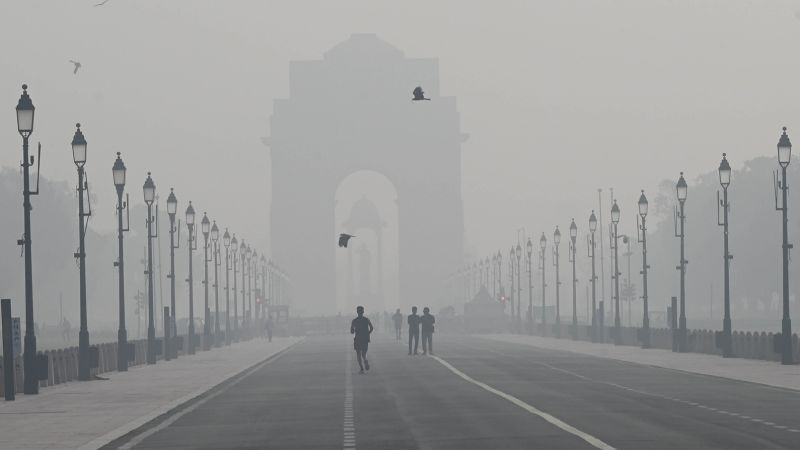Living in Delhi’s Smog: A Dystopian Cycle We Can’t Escape
Winter has arrived in Delhi, bringing with it the familiar veil of gloom. The once-clear skies are now shrouded in a thick, oppressive smog that hangs low over the city, casting a grey pall over everything. The air is so heavy that stepping outside for more than a few minutes feels like walking through a fog of ash. Even the slightest exertion—like brisk walking or a light jog—leaves people gasping for breath.
As the air quality worsens, most schools have been closed, and residents have been urged to stay indoors. But for those whose livelihoods depend on working outside, staying home is not an option. The air quality index, which reached a shocking 1,200 to 1,500 this week, is far above the acceptable threshold of 100. This alarming figure reflects the high levels of PM2.5 and PM10 particulate matter in the air—tiny particles that can infiltrate the lungs and cause a range of health problems.
On social media, the public has expressed a mix of shock, frustration, and despair. There’s an undeniable sense of déjà vu, as though the city is trapped in a recurring nightmare. For the past 15 years, this annual crisis has felt like a broken record, with no resolution in sight. A video from 2017 shows a drive through the thick smog, where visibility was reduced to under 2 meters. Remarkably, this year’s conditions are even worse.
The story of Delhi’s smog is one we’ve told many times before. We’ve documented how pollution is shortening lives, particularly for children, and how it disproportionately affects the poor, forcing them to work in hazardous conditions. Every year, politicians pass blame onto one another while doing little to address the root causes of the crisis. Solutions have been discussed and implemented with varying degrees of success, yet nothing substantial changes.
This relentless cycle of pollution, inaction, and blame feels like watching the same dystopian film over and over. The cast remains unchanged: the parks sit empty, the elderly and children are told to stay indoors, and daily wage laborers, rickshaw pullers, and delivery riders continue to work despite the coughing fits that accompany every breath. Hospitals are inundated with patients suffering from respiratory issues, but despite the mounting health crisis, the question remains: Why does nothing change?
The answer lies in the enormity of the problem. Solving Delhi’s air pollution requires coordinated, long-term efforts across multiple sectors. One of the major contributors is the annual crop burning in neighboring states like Punjab, Haryana, and Uttar Pradesh, where farmers set fire to crop residue to clear their fields. This practice, though harmful, is the cheapest option available to farmers. While various governments have proposed providing financial incentives and equipment to curb crop burning, progress on the ground has been minimal.
Delhi itself also contributes significantly to the pollution, with emissions from vehicles, construction, and factories exacerbating the problem. Every year, the cycle repeats: journalists report, politicians argue, and the public expresses anger—until the season passes, and everyone moves on, only to return to the same crisis the following winter.
In most democracies, a public health emergency of this magnitude would lead to mass protests. Yet in Delhi, the outrage remains largely confined to social media. Activists argue that the slow, cumulative nature of the damage—pollution doesn’t cause immediate health issues—has led to public apathy. A 2019 Lancet study found that air pollution in India led to over 2.3 million premature deaths. But for many, the effects are gradual, allowing life to go on as usual.
There’s also a clear class divide. Those who can afford to leave the city temporarily do so, while others invest in air purifiers or vent their frustrations online. For the rest, those without the means to escape or shield themselves from the smog, life continues as it always has.
So far, the collective anger has failed to spark the kind of widespread protest that might force action. As the Supreme Court has noted, politicians continue to “pass the buck,” waiting for the season to pass rather than tackling the issue head-on. Experts emphasize that a solution requires cooperation across political lines, with both the central and state governments working together on long-term, sustainable solutions. Citizens, too, must hold their leaders accountable, and courts must step in with decisive orders well before the pollution reaches dangerous levels.
As the season unfolds, temporary measures—like the ban on construction work—have been introduced, but will they be enough to clear the skies? History offers little hope that these short-term fixes will bring lasting change. Once again, Delhi is trapped in the smog, watching the same dystopian film unfold.



